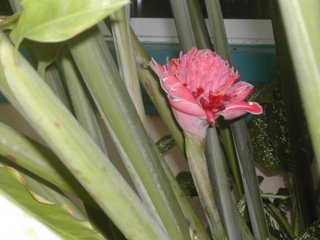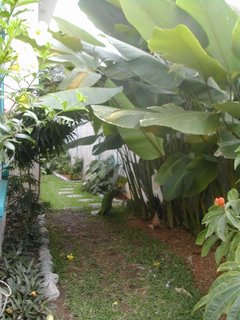I've had lots of tropical plants over the years. Most were kept in gallon-sized pots and babied through the winter, never growing very large because they were usually set back by the wrong wintertime conditions. Now when I buy some of these same tropicals and plant them in the ground here in hot, humid La Ceiba, they grow to be 8 or 10 feet tall and sometimes as wide.
When I gardened in Dallas, I remember looking for varieties of plants and flowers that would grow fast to make a more instant impact on the landscape. Here in the tropics I have the opposite problem. So many plants get too tall or too wide too fast and I never seem to leave enough room for them. You will never see one of those manicured magazine cover gardens here. It's impossible!
These pink gingers on either side of the front gate need to be divided every year because they get so overcrowded. And we have to cut them back every few months because they start blocking the gate. They do have a wonderful fragrance when they get smashed in the gate, though.
This picture was taken in July 2006. I planted this red ginger on both sides of the porch. I thought it was a dwarf type − my mistake. They were only about 6 inches tall when I planted them. Look at the old photo below from May 2005. They were the little short plants at the base of the column on the porch. We've already dug out several and replanted them elsewhere. Who knew?
This is the before photo taken May 2005. To give you some perspective, the birdbath is in the same place in the photo below.
This Etlingera elatior (common name here is Bastón de la Reina) was a scrawny stalk when I planted it a year and a half ago. You can see it in the old photo above to the right of the birdbath. I've thinned it heavily twice and now more drastic measures are needed. It's coming into the windows of the studio, growing across the front porch, and climbing over the roof.
 It gets the most beautiful flowers. They look as if they are made of wax. I have another one that is red, also planted from a stalk that my neighbor ripped out of the ground for me in the most brutal way. It's planted in an area where we almost have to crawl to get around it.
It gets the most beautiful flowers. They look as if they are made of wax. I have another one that is red, also planted from a stalk that my neighbor ripped out of the ground for me in the most brutal way. It's planted in an area where we almost have to crawl to get around it.
 This Calathea lutea grows wild near the creekbed. Three years ago I dug up three 3 foot tall plants each with only 2 to 3 leaves when we didn't have anything in the yard. The flowers are ugly − reddish brown drying quickly to brown − but I thought the large bluish-green leaves would help shade the windows on the west side of the house. They do, but they also block the walkway so that you need a machete to whack your way through this jungle.
This Calathea lutea grows wild near the creekbed. Three years ago I dug up three 3 foot tall plants each with only 2 to 3 leaves when we didn't have anything in the yard. The flowers are ugly − reddish brown drying quickly to brown − but I thought the large bluish-green leaves would help shade the windows on the west side of the house. They do, but they also block the walkway so that you need a machete to whack your way through this jungle.
 In the jungle by the creek they grow narrowly upright with only a few leaves, trying to reach the sun. In my garden, they reach up and out as well. We ruthlessly prune these every couple of months to no avail. The photo at the top of this article is of the east side, where they also block the walkway. I'll probably take out all of these eventually. They just aren't very well-behaved.
In the jungle by the creek they grow narrowly upright with only a few leaves, trying to reach the sun. In my garden, they reach up and out as well. We ruthlessly prune these every couple of months to no avail. The photo at the top of this article is of the east side, where they also block the walkway. I'll probably take out all of these eventually. They just aren't very well-behaved.
I'm learning as I go and will probably be doing a lot of rearranging as I make more mistakes. One benefit to this quick growth is that I rarely need to buy more than one of any kind of plant. Another is that I always have plenty of composting materials. Oh, by the way, all of these plants were free, stolen from the creek or given to me as cuttings.
When I gardened in Dallas, I remember looking for varieties of plants and flowers that would grow fast to make a more instant impact on the landscape. Here in the tropics I have the opposite problem. So many plants get too tall or too wide too fast and I never seem to leave enough room for them. You will never see one of those manicured magazine cover gardens here. It's impossible!
These pink gingers on either side of the front gate need to be divided every year because they get so overcrowded. And we have to cut them back every few months because they start blocking the gate. They do have a wonderful fragrance when they get smashed in the gate, though.
This picture was taken in July 2006. I planted this red ginger on both sides of the porch. I thought it was a dwarf type − my mistake. They were only about 6 inches tall when I planted them. Look at the old photo below from May 2005. They were the little short plants at the base of the column on the porch. We've already dug out several and replanted them elsewhere. Who knew?
This is the before photo taken May 2005. To give you some perspective, the birdbath is in the same place in the photo below.
This Etlingera elatior (common name here is Bastón de la Reina) was a scrawny stalk when I planted it a year and a half ago. You can see it in the old photo above to the right of the birdbath. I've thinned it heavily twice and now more drastic measures are needed. It's coming into the windows of the studio, growing across the front porch, and climbing over the roof.
 It gets the most beautiful flowers. They look as if they are made of wax. I have another one that is red, also planted from a stalk that my neighbor ripped out of the ground for me in the most brutal way. It's planted in an area where we almost have to crawl to get around it.
It gets the most beautiful flowers. They look as if they are made of wax. I have another one that is red, also planted from a stalk that my neighbor ripped out of the ground for me in the most brutal way. It's planted in an area where we almost have to crawl to get around it. This Calathea lutea grows wild near the creekbed. Three years ago I dug up three 3 foot tall plants each with only 2 to 3 leaves when we didn't have anything in the yard. The flowers are ugly − reddish brown drying quickly to brown − but I thought the large bluish-green leaves would help shade the windows on the west side of the house. They do, but they also block the walkway so that you need a machete to whack your way through this jungle.
This Calathea lutea grows wild near the creekbed. Three years ago I dug up three 3 foot tall plants each with only 2 to 3 leaves when we didn't have anything in the yard. The flowers are ugly − reddish brown drying quickly to brown − but I thought the large bluish-green leaves would help shade the windows on the west side of the house. They do, but they also block the walkway so that you need a machete to whack your way through this jungle.  In the jungle by the creek they grow narrowly upright with only a few leaves, trying to reach the sun. In my garden, they reach up and out as well. We ruthlessly prune these every couple of months to no avail. The photo at the top of this article is of the east side, where they also block the walkway. I'll probably take out all of these eventually. They just aren't very well-behaved.
In the jungle by the creek they grow narrowly upright with only a few leaves, trying to reach the sun. In my garden, they reach up and out as well. We ruthlessly prune these every couple of months to no avail. The photo at the top of this article is of the east side, where they also block the walkway. I'll probably take out all of these eventually. They just aren't very well-behaved.I'm learning as I go and will probably be doing a lot of rearranging as I make more mistakes. One benefit to this quick growth is that I rarely need to buy more than one of any kind of plant. Another is that I always have plenty of composting materials. Oh, by the way, all of these plants were free, stolen from the creek or given to me as cuttings.


 Welcome to my Blogicito —
Welcome to my Blogicito — 







